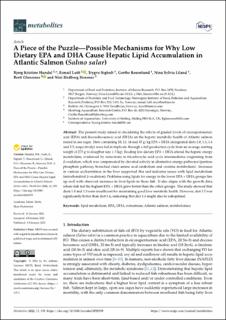| dc.contributor.author | Hundal, Bjørg Kristine | |
| dc.contributor.author | Lutfi Royo, Esmail | |
| dc.contributor.author | Sigholt, Trygve | |
| dc.contributor.author | Rosenlund, Grethe | |
| dc.contributor.author | Liland, Nina Sylvia | |
| dc.contributor.author | Glencross, Brett | |
| dc.contributor.author | Sissener, Nini | |
| dc.date.accessioned | 2022-08-31T08:44:08Z | |
| dc.date.available | 2022-08-31T08:44:08Z | |
| dc.date.created | 2022-05-23T09:10:19Z | |
| dc.date.issued | 2022 | |
| dc.identifier.citation | Metabolites. 2022, 12 (2), . | en_US |
| dc.identifier.issn | 2218-1989 | |
| dc.identifier.uri | https://hdl.handle.net/11250/3014633 | |
| dc.description.abstract | The present study aimed at elucidating the effects of graded levels of eicosapentaenoic acid (EPA) and docosahexaenoic acid (DHA) on the hepatic metabolic health of Atlantic salmon reared in sea cages. Diets containing 10, 13, 16 and 35 g/kg EPA + DHA (designated diets 1.0, 1.3, 1.6 and 3.5, respectively) were fed in triplicate through a full production cycle from an average starting weight of 275 g to slaughter size (~5 kg). Feeding low dietary EPA + DHA altered the hepatic energy metabolism, evidenced by reductions in tricarboxylic acid cycle intermediates originating from β-oxidation, which was compensated by elevated activity in alternative energy pathways (pentose phosphate pathway, branched chain amino acid catabolism and creatine metabolism). Increases in various acylcarnitines in the liver supported this and indicates issues with lipid metabolism (mitochondrial β-oxidation). Problems using lipids for energy in the lower EPA + DHA groups line up well with observed increases in liver lipids in these fish. It also aligns with the growth data, where fish fed the highest EPA + DHA grew better than the other groups. The study showed that diets 1.0 and 1.3 were insufficient for maintaining good liver metabolic health. However, diet 3.5 was significantly better than diet 1.6, indicating that diet 1.6 might also be suboptimal. | en_US |
| dc.language.iso | eng | en_US |
| dc.title | A Piece of the Puzzle—Possible Mechanisms for Why Low Dietary EPA and DHA Cause Hepatic Lipid Accumulation in Atlantic Salmon (Salmo salar) | en_US |
| dc.title.alternative | A Piece of the Puzzle—Possible Mechanisms for Why Low Dietary EPA and DHA Cause Hepatic Lipid Accumulation in Atlantic Salmon (Salmo salar) | en_US |
| dc.type | Peer reviewed | en_US |
| dc.type | Journal article | en_US |
| dc.description.version | publishedVersion | en_US |
| dc.source.pagenumber | 26 | en_US |
| dc.source.volume | 12 | en_US |
| dc.source.journal | Metabolites | en_US |
| dc.source.issue | 2 | en_US |
| dc.identifier.doi | 10.3390/metabo12020159 | |
| dc.identifier.cristin | 2026318 | |
| dc.relation.project | Norges forskningsråd: 273215 | en_US |
| dc.relation.project | Fiskeri- og havbruksnæringens forskningsfinansiering: 901282 | en_US |
| cristin.ispublished | true | |
| cristin.fulltext | original | |
| cristin.qualitycode | 1 | |
